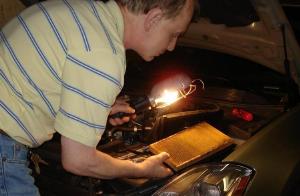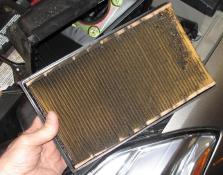
Home, Auto Repair Library, Auto Parts, Accessories, Tools, Manuals & Books, Car BLOG, Links, Index



Air filters stop silica and other solid contaminants by trapping the particles in the fibers that make up the filter media. Most air filters are made of resin treated cellulose (paper) that is combined with synthetic fibers. The typical paper air filter will trap most dirt particles that are 5 to 6 microns in size and larger, along with 80 to 90 percent of the particles down to a couple microns in size. Some of the best premium air filters will stop anything 2 microns or larger in size or larger, and most particles from 1 to 4 microns in size.
Air filters have to be efficient at trapping dirt, but also unrestrictive so the engine can breathe normally. For every gallon of fuel burned, 10,000 to 12,000 gallons of air will be pulled through the air filter! That's a lot of air, and it doesn't take long for dirt to buildup in the filter, especially if the vehicle is being driven in a dirty environment or on dusty gravel roads.
If the air filter is not changed, the trapped dirt will close up the pores in the filter and restrict airflow. The filter's efficiency to trap dirt will actually go up the dirtier it gets. But at the same time, the buildup of dirt will also make it harder and harder for air to pass through the filter. Consequently, the engine has to suck harder to get the same volume of air. This results in a noticeable drop in throttle response, engine performance and fuel economy. It can also cause carbon monoxide emissions to go up, and may even cause the vehicle to fail a tailpipe emissions test.
The OEM recommended replacement interval for many air filters today ranges from 30,000 to 60,000 miles, but these intervals are for ideal operating conditions. A more realistic service interval is to inspect the filter yearly, and replace it every two years or 24,000 miles -- or as needed depending on driving conditions.
To inspect the air filter, open the air filter housing (which is held shut with clips or fasteners), remove the filter and hold it up to a bright light. If the filter is very dark and transmits little light, it is dirty and needs to be replaced.

You might extend the life of an air filter a bit by tapping the filter against a hard surface to knock dust loose, or by vacuuming the side that stops the incoming dust. This will knock loose some of the surface dirt, but it cannot remove the dirt that is embedded in the fibers in the filter media. Do NOT attempt to wash a dry paper filter element as this may damage the filter.
When shopping for a replacement air filter, keep in mind that you often get what you pay for. The cheapest air filter may not provide the best protection for your engine. You want a filter that provides both high efficiency and longevity. Premium filters are more expensive, but typically use better quality media in the filter element that provides the best combination of filtering efficiency and dirt holding capacity. A good quality air filter should have an efficiency rating of at least 98.5%.
Performance air filters that offer reduced restriction are also available for many applications. Some replace the stock filter while others require removing the stock air filter housing and replacing it with a "cold air" intake system. Performance filters typically have a less coarse filter media for increased air flow with minimal pressure drop. But the trade-off may be less efficient filtration (more dirt gets through the filter) and less dirt holding capacity.
A word of caution about aftermarket low restriction cotton air filters (K & N brand, for example). The cotton filter element is less restrictive than a typical paper filter element, so people sometimes install these type of filters to improve airflow and horsepower. But to get dirt to stick to the filter, the cotton filter element is sprayed with a light coating of oil. On engines with mass airflow sensors, this can sometimes cause problems if some of the oil is drawn into the airflow sensor. The oil will contaminate the sensor, causing it to under-read airflow, resulting in performance problems and a possible Check Engine Light. The cotton filter elements are washable, and must be re-oiled after washing. So use oil very sparingly when you re-oil the filter if your engine has a mass airflow sensor.
 More Filter Articles:
More Filter Articles: Click Here to See More Carley Automotive Technical Articles
Click Here to See More Carley Automotive Technical Articles